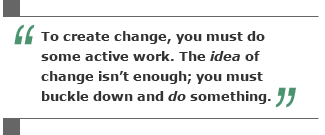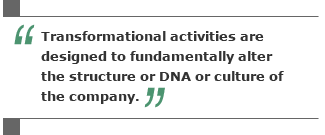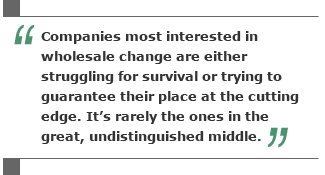You've probably heard these words before: The only constant is change. But in practical terms, what does that statement mean to executives? How are you supposed to act on it? And how do you know if you're making the right changes in the right way at the right time?
 |
John Fleming, Ph.D., has a pretty good idea. A Gallup principal and chief scientist of customer engagement and HumanSigma -- a management approach that helps organizations increase the bottom line by maximizing the employee-customer encounter -- Fleming has analyzed the successful and unsuccessful change efforts of dozens of companies. His research has given him insights into why some companies that initiate change succeed and why others fail.
Fleming's conclusion is that successful organizational change effort isn't a matter of will, but of action. And change doesn't have to be sweeping, expensive, or immediate, but it does have to be implemented correctly. Furthermore, real change shouldn't be "inflicted from the top down," as he says; it has to bubble up from the bottom too.
In this interview, Fleming discusses what transformational change requires from an organization. And even though fundamental change requires a lot of hard work and a lot of faith, for some companies, it's worth it.
GMJ: What's the secret to successful and sustainable organizational change?
Dr. Fleming: To create change -- to transform or alter how your company optimizes the value of its employees and customers -- you must do some active work. The idea of change on its own isn't enough; you must buckle down and do something. As Franklin Roosevelt said, "It is common sense to take a method and try it. If it fails, admit it frankly and try another. But above all, try something."
Too often, companies will decide that something has to change, then they implement some metrics to determine if they've been successful. Then they stop at the measurement phase, assuming that measurement by itself will improve performance. But in most situations, measurement is simply the first step.
GMJ: A lot of companies -- probably most -- don't have good objective performance metrics. But they do want to implement change.
Dr. Fleming: There's an interesting parallel here. In a recent study, we asked pharmaceutical sales reps to estimate how engaged their customers were using the CE11 [Gallup's 11-item customer engagement assessment] items as a hypothetical proxy. Then we actually measured the engagement levels of their customers using the CE11. What we found is that these two things were completely uncorrelated; sales reps' perceptions of how their customers felt had no relation to the customers' own feelings.
This example illustrates that in the absence of objective performance feedback, you're flying blind. No matter how good you think you're doing, you need the reality check that external metrics can provide.
Professor David Dunning and his colleagues at Cornell University recently did a study and found that in general, people are unaware of their own incompetence. In other words, it's difficult for people to know how bad they are at something. And the very fact that you're psychologically unable to recognize you are bad at something circumvents or short circuits your ability to improve. You need objective measurement to tell you how you're doing and to point the way toward making changes that will have an impact. (See "Can You Evaluate Your Own Abilities?" in the "See Also" area on this page.)
GMJ: But what do you do with those measurements? How do you know what will have the right kind of impact?
Dr. Fleming: First, you need the right measures. But then you must take action. There's a folk adage that really gets to the guts of all this: "If you pray for potatoes, you better grab a hoe -- but you also better grab the right hoe." You step back and ask yourself, "What kinds of actions or activities will likely bear the greatest fruit?"
GMJ: Give me an example of what these activities look like.
Dr. Fleming: Let's look at this in the context of improving customer and employee engagement, because that's an area of intense interest to me. When we think about actions that can be taken within an organization to improve customer and employee engagement, two different kinds of intervention activities are necessary: transactional and transformational. Both activities are designed to create sustainable organizational change.
 |
Transactional activities are episodic; they're focused events that occur in response to new performance data, such as training or action planning. First, you identify the things to improve, then you make changes, and then you look for those changes to have an impact on the metrics. If they do, you continue doing them; if they don't, you modify your actions. (See "You've Gotten Employee Feedback. Now What?" and "What to Do With Employee Survey Results" in the "See Also" area on this page.)
This becomes a repetitive process: You have data, you talk about it, you take action, you re-measure, you have more data -- it's essentially the scientific method in action. We call this a transactional process because in a sense, it's a transaction based on the data. Of the two types of intervention activities, companies are generally better at transactional ones, although only a few are really great at it.
GMJ: How do transformational activities differ from transactional ones?
Dr. Fleming: Transactional activities are designed to help you do the things you already do better, while transformational activities are designed to help you do things in new and better ways. Transformational activities -- whether they are driven at an enterprise level or at the workgroup level -- are interventions designed to fundamentally alter the structure or DNA or culture of the company.
Talent-based selection can fundamentally alter how you source talent and how you select and position people in your company. Implementing strengths-based development in your organization, for example, is a fundamental change in how you view the nature of your employees. Transformational interventions on the strategic level would include altering corporate strategy, redefining your brand promise, or other things that fundamentally change your organization.
There's another important distinction: If they're well executed, transactional activities tend to bear fruit rather rapidly. Transformational activities can take much longer, because they are designed to fundamentally change the way you do business.
GMJ: How should transformational change start? What are the first steps?
Dr. Fleming: Before embarking on a transformational intervention, you really need to have a strong voice from the top that both offers a carrot and a holds a stick. That voice has to cheerlead and provide substantive reinforcement for positive change while holding people accountable for a change in performance, however you measure that change.
That's one way that change can happen, and it's probably the most common. The folks at a major auto manufacturer have gone a different direction to create transformational change. Instead of mandating change, they've shown the value of change -- they've made an economic case for change. That's because no change initiative will work if it's inflicted from the top down. Change has to come from the bottom up too. For change initiatives to work, they must be collectively owned, engineered, and implemented.
The key is to understand the motivation of the people you're trying to persuade. For salespeople, for example, it's making money. So if you can show them a viable way to make more money, that will be compelling.
GMJ: Can transformational change be made bit by bit?
Dr. Fleming: It's very difficult to make fundamental alterations unless you have a champion with the authority to enact change and the urgency and vision to communicate to everyone why it is necessary. That generally requires someone in a high position in your organizational structure.
Without that much power, you must integrate change activities in pieces or sequentially. It's very hard to take on the whole organization at once. It's easier to road test your change in a smaller, more controllable environment and build your business case as you go. Often, someone within the organization proposes a particular type of change activity and implements it within his or her unit, which rarely is the entire company.
 |
But successfully implementing change in a smaller unit can create momentum for the larger organization to embrace it. If you can show proof that your change worked, you build a case that the change is useful, rather than another meaningless program that's inflicted on you.
GMJ: What advice do you give people when they ask if they need a transformational change?
Dr. Fleming: The companies that are most interested in wholesale change or disruptive technologies are those that are either struggling for survival or trying to guarantee their place at the cutting edge. It's rarely the ones that are swimming in the great, undistinguished middle.
GMJ: In the same way that the middle class never starts revolutions?
Dr. Fleming: Exactly. It's interesting that the companies we work with on transformational change are typically either struggling for survival or on the cutting edge, and not those in the middle. That's probably because they recognize an urgent need to create change. The ones in the middle are more cautious; they're not sure that transformation will be necessary because they're doing okay as they are.
GMJ: How do you know if your organization has really changed? How do you know if what you've done has been effective?
Dr. Fleming: Well, in almost all cases, you look for the business benefit of the changes that you've put in place. You measure to find out, for example, how developing people's strengths pays off in terms of employee productivity and retention and in customer outcomes. Ultimately, you want those transformational changes to improve your overall financial performance. But it all represents very hard work, and it takes time.
GMJ: How does a business leader know when it's the right time to implement change?
Dr. Fleming: Like Mark Twain said, "There are two times in a man's life when he should not speculate: when he can't afford it, and when he can." If your business is not performing, it's probably the right time to implement change. But that's not the only time. Another good time is when you're at the top of your game.
A need for transformational change is not necessarily predicated on a key finding from measurement data. It's based on a belief that altering the structure of your organization will make it perform better. For better or for worse, it requires a very large dose of faith that the transformational change you're trying to make will bear fruit. That faith is validated when you see the proof.
GMJ: None of this sounds easy.
Dr. Fleming: It's not. If you really want to make change, you must fundamentally alter the structure of your company. And that's hard, but sometimes it's the only way to continue into the future -- which makes it well worth the effort.
-- Interviewed by Jennifer Robison